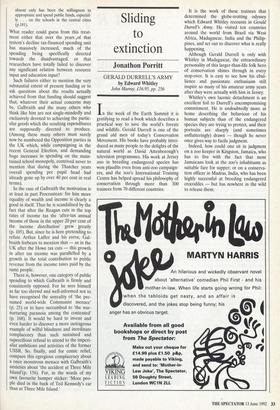A nudge is as good as a sneer
Antony Flew
THE CULTURE OF CONTENTMENT by John Kenneth Galbraith Sinclair-Stevenson, £14.95, pp. 195 This latest and perhaps last book by an author whom, we are told, is 'widely regarded as America's leading economist' is not an autobiography but a polemic. Its target is a politically dominant coalition of the contented, effectively opposed to tax increases. Galbraith advocates these mainly because he assumes them to be necessary and apparently sufficient to elevate the underclass of the inner cities and remedy the catastrophic condition of (much of) the public school system. His favourite method for disposing of dissent is not fairly to sum- marise, and then to attempt to refute the most formidable opposing arguments, but instead by winks, nods and sneers, to sug- gest that the views of opponents are suffi- ciently discredited merely by indicating their attractiveness to the contented.
For instance: Galbraith quotes, and of course deplores as altogether unacceptable to all left-thinking people, the disturbing conclusions of Charles Murray's massive study Losing Ground: American Social Policy 1950-1980 (pp. 105-7). But Galbraith never reveals that Murray reached those conclusion reluctantly and because he had found that expenditures already vast have not been and are not solving the problems which they were so benevolently intended to solve. Indeed, it even appears that in the long run they have actually been counter- productive.
Galbraith treats the deficiencies of the US public school system in the same way:
President George Bush has sought to have himself called the Education President; absent only has been the willingness to appropriate and spend public funds, especial- ly . . . on the schools in the central cities (p.181).
What reader could guess from this treat- ment either that over the years .of that system's decline tax-financed spending unit has massively increased, much of the spending being specifically directed towards the disadvantaged; or that researchers have totally failed to discover any significant relation between resource input and education input?
Such failures either to mention the very substantial extent of present funding or to ask questions about the results actually achieved from that funding should suggest that, whatever their actual concerns may be, Galbraith and the many others who think like him are not single-mindedly and exclusively devoted to achieving the partic- ular goods which the resulting expenditures are supposedly directed to produce. (Among these many others must surely now be numbered the Opposition parties in the UK which, while campaigning in the recent General Election, and demanding huge increases in spending on the main- tained school monopoly, contrived never to mention that during the Thatcher years overall spending per pupil head had already gone up by over 40 per cent in real terms).
In the case of Galbraith the motivation is at least in part Procrustean: for him more equality of wealth and income is clearly a good in itself. Thus he is scandalised by the fact that after the Reagan cuts in the top rates of income tax the 'after-tax annual income of those in the upper 20 per cent of the income distribution' grew greatly (p. 105). But, since he is here pretending to refute Arthur Laffer and his curve, Gal- braith forbears to mention that — as in the UK after the Howe tax cuts — this growth in after tax income was parallelled by a growth in the total contribution to public revenue from the income taxes paid by the same people.
There is, however, one category of public spending to which Galbraith is firmly and consistently opposed. For he sees himself as far too shrewd and well-informed not to have recognised the unreality of 'the pre- sumed world-wide Communist menace' (p. 25) or to have succumbed to 'the war- nurturing paranoia among the contented' (p. 168). It would be hard to invent and even harder to discover a more outrageous example of wilful blindness and inordinate complacency than such sustained and supercilious refusal to attend to the imperi- alist ambitions and activities of the former USSR. So, finally, and for comic relief, compare this egregious complacency about a once monstrous menace with Galbraith's anxieties about 'the accident at Three Mile Island'(p. 156). For, in the words of my own favourite bumper sticker: 'More peo- ple died in the back of Ted Kennedy's car than at Three Mile Island.'



















































 Previous page
Previous page